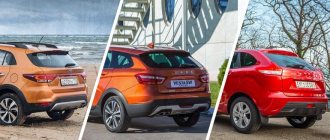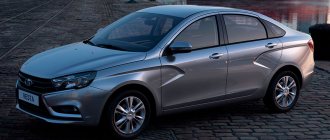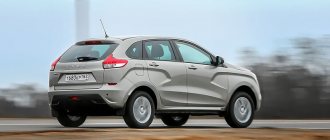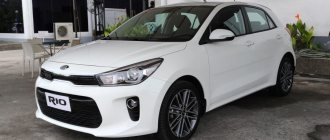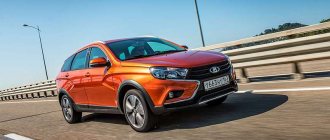Exterior
First, let's go over the appearance of the two Koreans.
Both cars have a tolerable design, however, the manufacturer Kia is positioning its model as a youth model, while Hyundai is for the older generation. But these frameworks are extremely arbitrary. The new Solaris has acquired a sharper frontal appearance. The headlights took on more square shapes and extended along the edges of the body. A huge air intake under the front bumper gave the car massiveness and solidity. From the side, the situation has practically not changed - the lines of the rear doors soaring upward, small windows and taillights - all this was present in the predecessor. There are also quite a few changes at the rear: the configuration of the rear bumper has changed and the reflectors have been transformed.
Kia Rio also has not undergone significant changes in terms of exterior. The front of the car was designed to give the car aggression and speed, which turned out quite well: the headlights acquired sharp angles and merged with the radiator grille, forming a semblance of a smile, a small air intake was located under the front bumper, and fog lights framed its edges.
It is impossible to identify a leader here. Both cars are designed with speed and style, but the way they implement this concept is different.
It's no secret that the KIA Rio and Hyundai Solaris are essentially twins, especially in technical terms. But if Hyundai is aimed at sedate buyers over the age of 30, then Rio was created with an eye on the youth audience. This determined its design, made in the style of “flowing lines”.
It's hard to resist such a car!
The profile of the car is slightly inclined forward, there are spectacular stampings along the side panels, the chrome of the window opening adds ambiance, the roof is slightly tilted back, and the rear, with its large lights, is very harmonious. All this merges into a modern and fresh image that attracts young people so much.
Harmony in the image - it is not surprising that many choose Rio.
Lada Vesta, however, is in no way inferior. But in it, sophistication is replaced by aggressiveness. Classically shaped headlights, an air intake and a radiator grille, combined together with the curve of the chrome lines, create the image of a modern sedan. Moreover, this appearance will suit any buyer, regardless of age.
A powerful front end is Vesta’s trump card!
The profile is no less impressive. You just have to look at the X-shaped lines of the panels and the rims to immediately fall in love with this car. But the stern didn’t disappoint either – the straight lines of the lights look great against the background of the chrome-plated LADA letters.
But the profile of the Lada is no worse.
What to choose: Lada Vesta or Volkswagen Polo
Our choice is the VW Polo Sedan. It is a more comfortable and generally problem-free car. But when buying it, be prepared for expenses. Tax, maintenance, CASCO and OSAGO will all cost 100 thousand rubles a year.
Vesta, although cheaper in price and maintenance (50 thousand rubles per year), but body corrosion, oil consumption and engine breakdowns will cause a lot of trouble.
Author: Nikolay Starostin
Which of these cars would you choose? Share your opinion in the comments below the article.
Interior
The interior of the cars is made in accordance with the manufacturers' statements about their character.
The Solaris salon has classic features, diluted with signs of modern technology. The stylish design determines the placement of elements on the dashboard: the symmetrically located tachometer and speedometer, illuminated by blue backlight, look elegant and attractive. However, there is an inconvenience that manifests itself in recessed door handles, which look ascetic against the background of everything else.
When looking at the interior of the Rio, one recognizes the strict notes of a sports car. The backlight is white, and the speedometer takes up significant space on the instrument panel. The advantage of the Rio at this point will be the leather-covered visor, where the Solaris has hard plastic in this place.
The interior of the two cars is well designed, with the only difference being that the Solaris console takes on a drop-shaped appearance, while the Rio console takes on an angular appearance. There are also no significant differences in ergonomics: the arrangement of elements in each car is logical and distributed in such a way as to ensure maximum comfortable operation.
But when you look inside the cars, you can see, if not outright plagiarism, then very similar motives in the interior design. It is noticeable that AvtoVAZ designers were impressed by the inner world of the Korean model.
The dashboard, center console, 3-spoke steering wheel are all pretty similar. Of course, one cannot deny Vesta’s interior originality and originality, but there are certainly similarities. On the other hand, both models are ok with ergonomics, and there are no complaints about visibility either. The finishing materials are of sufficient quality, as for class B.
But the interior of the Lada Vesta is no worse.
Engine characteristics and fuel consumption.
AvtoVAZ currently offers 2 engines of its own production. Their characteristics are approximately the following:
The engine has a power of 106 horsepower, and its volume is 1.6 liters, the speed provided by this engine reaches 178 km h. The engine with the highest power of 122 horsepower and a volume of 1.8 liters is the most powerful engine of the model. The most expensive foreign engine from Nissan-Renault has a volume of 1.6 liters with a power of 114 horsepower - but is still not installed on Vesta. The Polo has two engines of the same volume: 1.6 liters, but both have lower gasoline consumption compared to 2180, which is very pleasant for an economical driver. The first engine has 90 horsepower under the hood, the second has 110, despite the efficiency of gasoline, it successfully reaches speeds of up to 190 km/h.
As a result, the rival from abroad has more advanced engines, and the 1.8 engine of the Vesta is more powerful.
Options and cost
Both LADA Vesta and KIA Rio provide their customers with an abundance of trim levels - 6 for the Russian sedan and 7 for the Korean one. In general, Lada offers richer or similar equipment, and at a significantly lower price, which is especially noticeable in the basic trim levels. So, the price for Kia Rio starts from 601,900 rubles. and for Vesta - from 514,000 rubles. The difference is 87,900 rubles. very significant for this class.
Photo of KIA Rio in basic configuration.
In addition, top-end configurations for the 1.4-liter version of Rio are not offered at all, because they are intended only for 123-horsepower modifications. The maximum price for KIA Rio is RUB 871,900. And LADA Vesta – 658,000 rubles. That is, the difference grows to 213,900 rubles. For such a segment, this is an extraordinary reason to think!
The top LADA Vesta is noticeably cheaper!
LADA VESTA
| Equipment | Specifications | Price, rub.) |
| Classic | 1.6 l 16 cl. (106 hp), 5MT | 584 900 |
| Classic/Start | 1.6 l 16 cl. (106 hp), 5MT | 609 900 |
| Classic/Start | 1.6 l 16 cl. (106 hp), 5AMT | 634 900 |
| Comfort | 1.6 l 16 cl. (106 hp), 5MT | 637 900 |
| Comfort/Image | 1.6 l 16 cl. (106 hp), 5MT | 660 900 |
| Comfort | 1.6 l 16 cl. (106 hp), 5AMT | 662 900 |
| Comfort / Multimedia | 1.6 l 16 cl. (106 hp), 5MT | 665 900 |
| Comfort | 1.8 l 16 cl. (122 hp), 5MT | 672 900 |
| Comfort/Image | 1.6 l 16 cl. (106 hp), 5AMT | 685 900 |
| Comfort / Multimedia | 1.6 l 16 cl. (106 hp), 5AMT | 690 900 |
| Comfort/Image | 1.8 l 16 cl. (122 hp), 5MT | 695 900 |
| Comfort | 1.8 l 16 cl. (122 hp), 5AMT | 697 900 |
| Luxe | 1.6 l 16 cl. (106 hp), 5MT | 700 900 |
| Comfort/Image | 1.8 l 16 cl. (122 hp), 5AMT | 720 900 |
| Luxe | 1.6 l 16 cl. (106 hp), 5AMT | 725 900 |
| Luxe / Multimedia | 1.6 l 16 cl. (106 hp), 5MT | 728 900 |
| Luxe | 1.8 l 16 cl. (122 hp), 5MT | 735 900 |
| Luxe / Prestige | 1.6 l 16 cl. (106 hp), 5MT | 746 900 |
| Luxe / Multimedia | 1.6 l 16 cl. (106 hp), 5AMT | 753 900 |
| Luxe / Multimedia | 1.8 l 16 cl. (122 hp), 5MT | 763 900 |
| Luxe / Prestige | 1.8 l 16 cl. (122 hp), 5MT | 781 900 |
| Luxe / Multimedia | 1.8 l 16 cl. (122 hp), 5AMT | 788 900 |
| Luxe / Prestige | 1.8 l 16 cl. (122 hp), 5AMT | 806 900 |
| Exclusive | 1.8 l 16 cl. (122 hp), 5MT | 814 400 |
| Exclusive | 1.8 l 16 cl. (122 hp), 5AMT | 839 400 |
More on the topic: Which is better: Kia Rio or Hyundai Solaris
Current configurations and prices for Lada Vesta are available at LINK
KIA RIO
| Equipment | Specifications | Price, rub.) |
| Classic H0S4K4617 | 1.4 l 100 l. With. 6MT | 709 900 |
| Classic Audio H0S4K4617 | 1.4 l 100 l. With. 6MT | 744 900 |
| Comfort H0S4K4617 | 1.4 l 100 l. With. 6MT | 769 900 |
| Comfort H0S4K461F | 1.4 l 100 l. With. 6AT | 809 900 |
| Comfort H0S4D2617 | 1.6 l 123 l. With. 6MT | 794 900 |
| Comfort H0S4D261F | 1.6 l 123 l. With. 6AT | 834 900 |
| Luxe H0S4D2617 | 1.6 l 123 l. With. 6MT | 819 900 |
| Luxe H0S4D261F | 1.6 l 123 l. With. 6AT | 859 900 |
| Prestige H0S4D2617 | 1.6 l 123 l. With. 6MT | 919 900 |
| Prestige H0S4D261F | 1.6 l 123 l. With. 6AT | 959 900 |
| Premium H0S4D261F | 1.6 l 123 l. With. 6AT | 1 019 900 |
Current configurations and prices for KIA Rio are available at LINK
As you can see, a comparison of the Kia Rio and Lada Vesta clearly shows that the significant difference in cost is due, first of all, to a more powerful engine, a 6-speed automatic transmission and finishing elements. Indeed, in terms of equipment, the models are approximately equal, and the advantage of Rio in the number of airbags is offset by the large number of electronic systems in Vesta.
The basic equipment includes power windows, heated windows and audio preparation, that is, everything that should be in a modern car.
Markups or discounts?
Hyundai Solaris did not cause such a stir as the Creta: two weeks after the start of sales, cars with automatic transmissions are in stock at almost all dealers.
But you will have to hunt for “mechanics” and inexpensive trim levels. The problem is that most Hyundai dealers, sensing a taste of easy money from the example of the Creta, immediately put alarms, engine compartment protection and other “extras” on Solaris. The average size of such a markup is 50 thousand rubles, but the amount sometimes reaches 100 thousand. At the same time, there are no discounts on the new Solaris and are not expected in the near future. So there is only one way to buy a Hyundai profitably - put pressure on the manager and refuse the “extras” under any pretext.
Buy Rio, Polo or Vesta? No problem! The seller will also increase the price.
Kia has a centralized discount on the most popular versions of Rio (it is declared by the representative office) of 20 thousand rubles, on less popular ones - 40 thousand. The dealer himself is ready to throw off a maximum of another ten thousand rubles or make a nice gift within this amount.
In Volkswagen and Lada they bargain more willingly - with some persistence you can get a concession of 60 thousand rubles.
In other words, for a real buyer with 700 thousand in his pocket, any Lada is available, but Kia and Volkswagen for this money can offer either a “mechanics” in the middle configuration, or an “automatic”, but almost naked. And Hyundai only has a small 1.4 engine, a “handle” and a living wage for the Active Plus version. And then if you are lucky enough to find such a Solaris without dealer extras.
What else can you get for 700 thousand rubles?
I would immediately dismiss the Chinese fraternity due to the incomprehensible situation with reliability, availability of spare parts and low resale price on the secondary market.
Ford Fiesta? It is even tighter than the Rio, the trunk is modest, and even taking into account large dealer concessions (up to 70 thousand rubles!) and discounts for the 2021 release year, the Fiesta 1.6 Trend with a “robot” will barely fit into the 700 thousand budget.
Renault Logan? In the case of Logan, dealers of the French brand are reluctant to bargain; in Moscow you can extract a maximum of 30 thousand rubles from them from the price list. That is, our budget includes a metallic-painted Logan 1.6 (102 hp) in a fairly rich Privilege package with a safety package (ESP, side airbags, parking sensors). But the Logan is rustic to drive, uncomfortable and noisy inside, and the main problem is the ancient and unreliable four-speed DP2 automatic transmission.
Ravon R4
There is also the Ravon R4, that is, the Chevrolet Cobalt renamed in Uzbekistan (the first cars began to arrive at Moscow dealers after we completed this test), which was quite good to drive, had a strong suspension, was spacious and reliable. We also liked the combination of a playful one and a half liter engine (106 hp) and a six-speed automatic transmission.
And all this with air conditioning for only 600 thousand rubles - come and get it! True, the R4 does not have a stabilization system in any of the trim levels. And don't rely on dealer discounts. Because in the next few months you can expect an increase in price, as was the case with the Nexia R3 after the start of sales last year.
* Excluding discounts for trade-in, disposal and purchase on credit
More on the topic: Engine of HYUNDAI SOLARIS and KIA RIO (GAMMA and KAPPA - G4FA, G4FC, G4FG and G4LC). Reliability, problems, resource - my review
Specifications
The differences are small, but they naturally exist. It’s worth following them, but it’s better to do a test drive before buying – the difference in technical characteristics of one model from another seems too insignificant. This means that sensations matter.
| Kia Rio | Hyundai Solaris | |
| Engine |
|
|
| Consumption |
|
|
| Suspension |
|
|
| Dynamics | Acceleration 0-100 km/h: 11.5 s. Maximum speed: 190 km/h | Acceleration 0-100 km/h: 11.5 s. Maximum speed: 190 km/h |
| Brakes |
|
|
| Dimensions |
|
|
| Where is it produced? | Russia, near St. Petersburg | Russia, near St. Petersburg |
| Safety |
|
|
| Other |
|
|
More on the topic: Hyundai Solaris body colors - photo of a white, black and red model
Everything you need to know about the competitors of the new VW Polo
In order to choose the best model in comparison with the Volkswagen Polo, the price of which starts at 790 thousand and ends at 1 million 210 thousand rubles, we will do a comparative analysis of the trim levels and prices of competitors.
Why were five cars selected from classmates of the German liftback, with approximately the same price ranges and configurations, namely:
- starting from 860 thousand and up to 1 million 200 thousand of our money - Kia Rio ;
- from 870 thousand to 1 million 290 thousand - Skoda Rapid .
- Lada Vesta is estimated from 700 thousand to 950 thousand Russian rubles ;
- in the range from 746 thousand to 1 million 11-odd thousand - Hyundai Solaris ;
- and also from 860 thousand to 1 million 255 thousand - Ford Focus
Latest materials
Detailed analysis of the VW Polo Liftback suspension
Scheduled maintenance for warranty VW Polo Liftback
From this list it is clear that the Volkswagen Polo, like its competitors, are cars just for those of our garage comrades who “don’t fit in with the family” or with average income levels.
As for the configurations and prices of the Polo, they are presented in the table below:
Engine type, volume, power, gearbox type
As for the specific list of options, the initial assembly of the Polo already has:
- two airbags for the pilot and navigator. As, indeed, are all competitive Polo models;
- 6.5 inch multimedia screen;
- LED low beam headlights;
- 15 inch wheels.
The Respect package is equipped with air conditioning, heated seats, washer sprays, and mirrors, in other words, it has a winter package of options. By the way, competitors usually offer these options as additional equipment for an additional fee.
The Status assembly comes with a leather-wrapped steering wheel, equipped with buttons and heating, with climate and cruise control, and alloy wheels.
Regarding the top-end Exclusive version, it should be said that it is equipped with a virtual tidy, 8-inch multimedia, LED optics, rear and front parking sensors, a start button, and chrome trim for interior elements.
At the same time, the German liftback, according to independent media (in particular, the same “Autoreview”) compares favorably with its competitors:
- in Russian road conditions - smooth suspension;
- good sound insulation and, accordingly, acoustics;
- reliable management;
- a wide range of “smart” options, or as it is now fashionable to talk about certain assistants with artificial intelligence.
Negative Polo positions are:
- weak acceleration dynamics with DSG transmission;
- the need to pay extra for ESP;
- The basic version of Origin does not have air conditioning.
However, the cost of the Polo is by no means more expensive than competitive models. For example, the same Skoda Rapid, already in its initial assembly, is valued at more than 870 thousand Russian rubles. Actually, let’s start comparing the twins with a relative, both by class and by VAG group (as well as by place of production for Russians, namely in Kaluga).
Both, as our garage comrades jokingly call them “low-cost airlines,” have, first of all, features invisible to users, such as increased washer capacities compared to European versions of the models. As well as more powerful batteries, as well as corresponding generators. In general, everything that our brother lacks for Russian road packages, which come as separately paid extras.
Engine type, volume, power, gearbox type
Rapid at one time left the European markets due to strict environmental requirements there, so it appeared here, although even in terms of the price tag in basic assemblies it cannot compete with Polo, having almost 80 thousand more of our money. Although in all other respects, including appearance, the Rapid is an identical twin of the German liftback from the same concern.
Engine
It makes no sense to compare the power units of two foreign cars - they are the same. The cars are equipped with two engine options: 1.4 liters with a power of 107 hp. With. and 1.6 l 123 l. With. The dynamics provided by these engines are quite sufficient for city cars, however, the Rio clearly lacks the agility inherent in youth cars.
With the gearbox, everything is also quite clear: 2 manual transmission options with 5 and 6 stages and 2 automatic transmissions with 4 and 6 ranges.
It should be said about the six-speed manual transmission, which is installed on 123-horsepower engines. One of the gears is redundant, a weak engine will not allow you to feel the drive from driving or better feedback, so increasing the cost for a 6-speed manual transmission is a waste.
Both Koreans have hydraulic power steering systems and disc brakes. The chassis has an independent front axle and MacPherson struts.
On the road, the sedans are similar in many ways, but the Kia seems sharper and more collected, unlike its Korean counterpart. Hyundai is calmer and softer, which is what a reputable car should have.
Chassis and ground clearance
Vesta's ground clearance (ground clearance) is greater than Polo's: 178mm versus 163mm.
The chassis used to be the weak part of AvtoVAZ cars, so solving this problem is the main task. By adding a subframe plus L-shaped arms to the new model, AvtoVAZ achieved increased safety, driving comfort and body rigidity. Vesta's rear suspension is taken from Renault Nissan, which, according to manufacturers, can last up to 150 thousand kilometers without breakdowns. The front suspension is located on the Vesta subframe. And for the first time for Lada, the power steering is not built into the steering mechanism.
Volkswagen is also pleased in this matter. The Polo's chassis is suitable for our roads, this is due to the fact that the polo's front suspension is an independent MacPherson system (the name of the famous engineer). This system is lighter, cheaper, and increases comfort on the road. The rear semi-independent suspension was taken from the Golf IV, modified, turning into a completely new suspension, with increased endurance of the components, and most importantly, it increased the quality of car control.
What's the result?
And now - a little pure gag. Did you notice that in the text I never went into compliments, did not use the expressions “for the first time in a Russian car,” and so on? Because enough drool and snot. It's time to treat AVTOVAZ like a normal automaker. Accordingly, demand from him that the products are at least at the level of competitors.
Kia Rio is one of the leaders not only in the segment, but also in the Russian car market as a whole. On its side is a neat interior, a pleasant, although not the brightest, design, and an already well-established image of a reliable, durable car. I am personally ready to answer for each of these statements. Hyundai Solaris is exactly the same, only different, with blue backlighting. Personally, I don't like it only in terms of design. Well, what is there: this blue color in the cabin infuriates me!
Lada Vesta is a promising contender that can take away a significant share of buyers from the leaders. Thank God that the suspension is smartly tuned for bad roads - in our country there are many more of them than high-speed serpentines. What can I say, there is almost no place to implement good handling in Russia, and potholes are now found even on the central streets of cities with a population of over a million, not to mention the outback.
I would (I didn’t expect it myself) choose the Russian new product. Not for patriotic reasons. I just like her better, without any reservations. The only thing that can prevent Vesta from becoming a bestseller is the high price. I want to believe that Bo Andersson understands this. And before the price list is announced, I'm keeping my fingers crossed.
https://www.youtube.com/watch?v=MTh4iJWwY_Y
It is difficult to give preference in choosing two twin brothers, which are Rio and Solaris. Both cars have similar disadvantages and advantages, and their purchase and technical support costs differ slightly. Apparently, if you are thinking about buying one of these foreign cars and cannot decide which is better, then you should choose based on your preferences in appearance and interior design.
More about Solaris
- What is better Hyundai Solaris or Audi A4
- Let's choose the best car between Kia Rio and Hyundai Solaris
- Which is better Hyundai Solaris or Hyundai Sonata
- Choice: Hyundai Solaris 2011 or Ford Mondeo IV 2010?
- Which is better Lada Vesta or Hyundai Solaris, reviews
- Comparison of Lada Vesta and Hyundai Solaris
- Comparison of Kia Rio and Hyundai Solaris hatchbacks
- Which is better: Kia Rio or Hyundai Solaris
- Nissan Almera or Hyundai Solaris - which is better: comparison of cars
- Comparison of Renault Logan and Hyundai Solaris
Visibility
Vesta pleases with the largest mirrors, but disappoints with the most massive windshield pillars and the highly raised edge of the trunk. The wiper cleaning sector is good, just like its rivals. And Lada became a leader in terms of visibility only thanks to its equipment: in a budget of up to 750 thousand rubles, foreign cars do not offer parking sensors, a camera or an electrically heated windshield.
Rio and Solaris have thinner pillars than West ones, and, on the contrary, smaller mirrors. But in Kia, the “indirect viewing devices” are of the correct shape, while in Hyundai they are flattened. Fortunately, the interior mirror helps: Solaris has the largest rear window opening.
More on the topic: Engine life of Hyundai Solaris 1.4, 1.6
In Polo, alas, it is much smaller and, moreover, is more blocked by headrests. And the side mirrors of Volkswagen can be called “make-up” mirrors. The windshield pillars are the thinnest, but have massive triangles at the bases that block the view of even drivers of average height. You will have to turn your head in Polo more than in other cars.
Lada Vesta
Hyundai Solaris
Kia Rio
Volkswagen Polo
Prestige and body
A German is a German! In this regard, Volkswagen does not lack status. Noble pedigree, reliability proven over the years, the admiration of customers and the famous emblem on the hood - Vesta has yet to travel this path. But she is already taking her first big steps. Of course, AvtoVAZ is still far from reaching the level of prestige of the German brand, but is the VW nameplate worth the overpayment that is being asked for it?
Polo is the experienced old-timer of the class.
In terms of body styles, there is parity - both models have only sedans. However, the Lada Vesta still has a potential advantage, because the marketers of the Russian company assured that a model in hatchback and station wagon bodies will soon enter the market, after which it will become much more difficult for the Polo to compete with our car.
The appearance of the Lada Vesta station wagon is “just around the corner.”
In addition, from a comparison of the parameters it is clear that the Lada Vesta is superior to its counterpart (Vesta on the left, Polo on the right):
— length – 4,410 mm versus 4,390 mm;
— width – 1,764 mm and 1,699 mm;
— height – 1,497 mm versus 1,467 mm;
- ground clearance - 178 mm and only 163 mm for Polo;
- trunk volume - 480 liters versus 460 liters.
— weight – 1,230 kg (1,670 kg) versus 1,163 kg (1,700 kg).
In addition, the Lada Vesta has a larger wheelbase, which affects the interior space. Against 2,635 mm, Volkswagen demonstrates only 2,553 mm.
In terms of dimensions, the Russian sedan outright outperforms the German.
Which car has a better and more ergonomic interior?
Neither Vesta nor Solaris can boast of interior trim materials that are pleasant to the touch - “oak” plastic, creaky. But the “Korean” does not have giant gaps between the parts, and the “Russian” has more niches for small things on the road.
Both cars are a bit cramped; the rear sofa is designed for two miniature passengers. There is also a slight difference in the volume of the cargo compartment - 465 liters for Solaris versus 480 liters for Vesta.
In terms of basic configurations, Vesta outshines Solaris. As standard, it has not only two airbags and ABS, but also:
- emergency braking and hill starting assistance system;
- air conditioning;
- adjustable steering wheel height and reach;
- 12V socket;
- full-size spare wheel.
The simplest Solaris has only two airbags, ABS, front electric windows, a cigarette lighter with an ashtray and a height adjustable steering wheel.
At city speeds, the interiors of both cars are relatively quiet. When the speedometer needle goes beyond the first hundred, the driver has to raise his voice so that the rear passengers can hear him. Solaris owners especially strain their ligaments. One gets the feeling that the Korean sedan has no sound insulation at all.
Also read: Used Hyundai Solaris I: what to expect from the car






